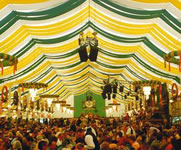A visit to the Museum of Natural History in Berlin is a must for anyone interested in nature. It presents information on a wide range of topics relating to evolution and gives visitors an opportunity to discover and understand interrelationships in nature of which they were previously unaware. The museum is famous for having the biggest dinosaur skeleton of the Brachiosaurus brancai. It also has a number of other natural history objects that illustrate the history of evolution and the third-largest collection of meteorites in Europe. Guided tours are available, closed on Mondays, 24 Dec., 25 Dec. and 31 Dec.
» www.museum.hu-berlin.de
Dating back to the natural history specimens collected by the dukes of Württemberg in 1791, the State Museum for Natural History in Rosenstein Palace has a long tradition and is one of the foremost scientific collections in Europe. In addition to mammals, the museum also has a large number of beetles and butterflies. Designed with great attention to detail, the exhibition area offers an insight into the diversity of life on earth. As well as a large insect collection, there is a spectacular original skeleton of a Sei whale with inner organs. A separate exhibition area houses a walk-through, three-dimensional "classification book" for indigenous animals. Visitors can discover and explore a variety of different habits - from forests, moors and fields to crags, all of which have been reconstructed in realistic detail. Closed on Mondays. Guided tours available.
» www.naturkundemuseum-bw.de
Situated in Erfurt's old quarter, the Museum of Natural History was founded in 1922. Covering an exhibition area of approx. 1,200 m˛ across four floors, it provides information about various natural habitats in Thuringia. When visitors enter the museum, their gaze is immediately drawn to a 350-year-old English oak, which stands 14 metres high and appears to grow through each of the museum's floors. Among the zoological collections, the entomological collection is the most extensive with 350,000 insects (2,000 different species), followed by the herpetological collection with 4,500 amphibians and 800 reptiles, 4,000 birds, 1,200 mammals, 12,500 plants, 15,000 fossils, 7,000 minerals and much more. Closed on Mondays.
» www.naturkundemuseum-erfurt.de
Since 2006, the wild sea has been whipping up a storm at this 6,000m˛ exhibition in Büsum harbour. "Sturmflutwelt Blanker Hans" (Blanker Hans World of the Storm Tide) shows the true face of the roaring, harsh North Sea. Visitors are immersed in virtual flood worlds and can learn all about the natural phenomenon of the storm tide on an entertaining visit to the offshore research station. The adventure begins with a trip in one of our "rescue capsules". The multimedia exhibition also looks at a range of other issues, such as weather phenomenons, the water cycle, climate change, the tides (e.g. what causes a storm tide), the history of storm tides up to the present day and the protection of the coastline. It also illustrates how worms, crustaceans, sea lavender and nesting birds cope with the extreme water levels and looks at the region's dyke defences. Films and eye-witness reports are used to document the forces of nature. Wheelchair access, guided tours available.
» www.blanker-hans.de
The Museum of Natural History in Münster, which covers an area of approx. 4,000m˛, offers an insight into the world of stars, dinosaurs, Native Americans, mammoths, mammoth hunters and the history of mankind. Experience "heaven on earth" and travel back in time to the Mesozoic era in the blink of an eye. You'd better not be scared of big animals if you want to see the giant dinosaurs on display, including the 16-metre-long skeleton of a Tyrannosaurus rex and the remains of dinosaurs that lived here 100 million years ago. In addition to important fossil finds, the museum also houses a number of impressive special exhibitions. The museum's planetarium takes visitors on a journey to the stars with a beautiful simulation of the night sky. Closed on Mondays, guided tours on request.
» www.lwl.org
The State Museum of Natural History in Görlitz focuses on the traditional areas of zoology, botany and geology. However, the main emphasis is on soil biology. In an exhibition area of approx. 1,200 m˛, the museum has millions of insects, mites, millipedes, snails, crustaceans, vertebrates, plants and fungi as well as thousands of minerals, rocks and fossils that have been preserved and scientifically analysed. Interactive multimedia shows and video films help turn a visit to the museum into an unforgettable experience. The exhibition also includes an attractive vivarium containing living exotic and native animals. Multilingual audio guides are available.
» www.naturkundemuseum-goerlitz.de
The museum was founded in 1912 by the zoologist Alexander Koenig, who became renowned for his research and collecting tours to Africa and the polar regions. One of the most acclaimed natural history museums in Germany, it houses exquisite zoological collections, dioramas, in particular of African habitats, and the famous Bengt-Berg bird collection. The museum aims to give visitors the opportunity to experience the interdependence within nature and the problematic relationship between man and nature with all their senses. The permanent exhibition entitled "Our Blue Planet – Life in the Network" shows examples of the richly varied collections covering savannah, rainforest, Arctic/Antarctic, central Europe, birdlife and vivarium. There are also a number of temporary photographic and special exhibitions. Closed Mondays, 24 Dec., 25 Dec. & 31 Dec. Guided tours on request.
» www.museum-koenig.de



